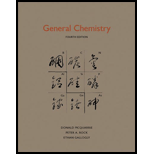
Concept explainers
(a)
Interpretation:
Average density of lead that is determined by each group has to be calculated and also the percentage error in the average density of each group has to be calculated.
Concept Introduction:
Accuracy can be measured using percentage error. Percentage error is the difference between the average experimental values and/or true value, divided by true value, multiplied by
(a)
Explanation of Solution
Average density and percentage error obtained by Group 1:
Three density values of lead is obtained by Group 1 and they are
Therefore, average density of lead obtained by Group 1 is
True value of density of lead is
Percentage error obtained by Group 1 is
Average density and percentage error obtained by Group 2:
Three density values of lead is obtained by Group 2 and they are
Therefore, average density of lead obtained by Group 2 is
True value of density of lead is
Percentage error obtained by Group 2 is
Average density and percentage error obtained by Group 3:
Three density values of lead is obtained by Group 3 and they are
Therefore, average density of lead obtained by Group 3 is
True value of density of lead is
Percentage error obtained by Group 3 is
(b)
Interpretation:
The most accurate data among the Group’s data has to be identified.
Concept Introduction:
Precision of the quantities that are measured use the significant figures to express the result. Precision tells about the closeness of values to each other in a measurement.
Accuracy is a state that tells about the result obtained from experiment corresponds to the actual value or true value.
(b)
Explanation of Solution
Density of lead is
(c)
Interpretation:
The most precise data among the Group’s data has to be identified.
Concept Introduction:
Refer part (b).
(c)
Explanation of Solution
Density of lead is
Want to see more full solutions like this?
Chapter 1 Solutions
General Chemistry
 ChemistryChemistryISBN:9781305957404Author:Steven S. Zumdahl, Susan A. Zumdahl, Donald J. DeCostePublisher:Cengage Learning
ChemistryChemistryISBN:9781305957404Author:Steven S. Zumdahl, Susan A. Zumdahl, Donald J. DeCostePublisher:Cengage Learning ChemistryChemistryISBN:9781259911156Author:Raymond Chang Dr., Jason Overby ProfessorPublisher:McGraw-Hill Education
ChemistryChemistryISBN:9781259911156Author:Raymond Chang Dr., Jason Overby ProfessorPublisher:McGraw-Hill Education Principles of Instrumental AnalysisChemistryISBN:9781305577213Author:Douglas A. Skoog, F. James Holler, Stanley R. CrouchPublisher:Cengage Learning
Principles of Instrumental AnalysisChemistryISBN:9781305577213Author:Douglas A. Skoog, F. James Holler, Stanley R. CrouchPublisher:Cengage Learning Organic ChemistryChemistryISBN:9780078021558Author:Janice Gorzynski Smith Dr.Publisher:McGraw-Hill Education
Organic ChemistryChemistryISBN:9780078021558Author:Janice Gorzynski Smith Dr.Publisher:McGraw-Hill Education Chemistry: Principles and ReactionsChemistryISBN:9781305079373Author:William L. Masterton, Cecile N. HurleyPublisher:Cengage Learning
Chemistry: Principles and ReactionsChemistryISBN:9781305079373Author:William L. Masterton, Cecile N. HurleyPublisher:Cengage Learning Elementary Principles of Chemical Processes, Bind...ChemistryISBN:9781118431221Author:Richard M. Felder, Ronald W. Rousseau, Lisa G. BullardPublisher:WILEY
Elementary Principles of Chemical Processes, Bind...ChemistryISBN:9781118431221Author:Richard M. Felder, Ronald W. Rousseau, Lisa G. BullardPublisher:WILEY





